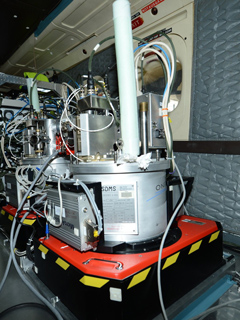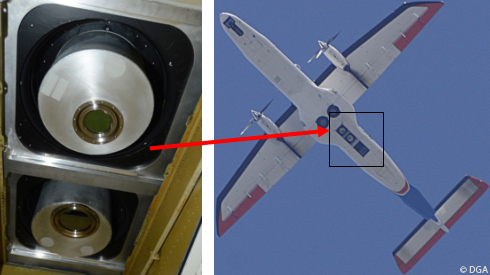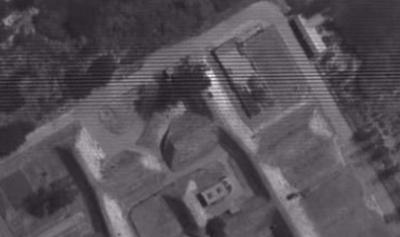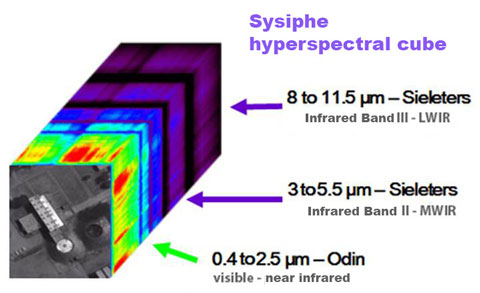Onera has designed and developed Sieleters, an instrument intended to be an airborne infrared hyperspectral imagery benchmark. The first images obtained with it, which are of excellent quality, will undoubtedly achieve this goal.
In September 2013, Sieleters – an exceptional infrared hyperspectral imaging system – was able to provide its first images during the Sysiphe airborne campaign. During this campaign, it was associated with the Norwegian instrument Odin-1024 designed for visible and near-infrared hyperspectral imaging.

The Sieleters instrument installed on the DO228 aircraft of the German DLR

The two optical modules of the Sieleters instrument viewed from below the aircraft (installed on the hatch)
Sieleters is a cryogenic instrument with two separate optical modules operating respectively in the "medium wave" (3 to 5 µm) and "long wave" (8 to 12μm) infrared bands. Sieleters, designed to have a high signal/noise ratio, is cooled with liquid nitrogen (-190 ° C). The assembly is mounted on two gyrostabilized platforms paired so as to compensate for the attitude variations of the aircraft.
The aircraft and therefore the Sieleters instrument move past the scene. The fringes are fixed and are imaged together with the scene. The contrast and interfringe vary, according to the spectral content of the scene.

Here, we can distinguish better the interference fringes that are superimposed on the scene image. The whole forms an interferometric image
From an altitude of 2000m, each of Sieleters’ optical modules acquires airborne interferometric images over a 500m swath, with a ground resolution of 50 cm.
After post-processing, Sieleters yields a cube of perfectly aligned and geo-referenced spectral images. This cube is a stack of 180 monochrome images of the same scene, each in a narrow and contiguous spectral band. This spectral cube will be used in very diverse areas: bathymetry, de-camouflaging, pollution, agriculture, urban planning, etc.

Sysiphe hyperspectral cube representation. After processing, all of the Sieleters interferometric images will be transformed into such structures.
Sieleters’ images are currently undergoing post-processing to produce spectral image cubes. The quality of the raw images produced during the first flight in September 2013 was excellent. The spectral images produced will thus allow the scene characteristics to be shown very accurately.
The Sieleters instrument is a success for Onera and its financial backer, the Armament Procurement Agency of the French Ministry of Defense, DGA (Direction Générale de l'Armement). This success is shared by its partners and suppliers:
- AIEC: instrument aeronautical certification
- Applanix: instrument attitude measurement and restitution systems (piloting and control of the line of sight
- Corrélane Technologie: DGPS positioning system (ground and instrument)
- DGA-EV: in-flight tests
- DLR: aircraft
- Dspace: Real-time control computer for the instrument stabilization platform
- Façons mécaniques: general mechanics (instrument stabilization platform and cryostat top)
- Leica: motorized gimbals (instrument stabilization platform)
- Magellium: geo-referenced grid generation tools
- SDMS: cryogenic vacuum optical chambers - cryostats (and thermodynamic calculations)
- Sermeca: model of an airplane floor, 1:1 scale
- SFEA: aircraft and laboratory wiring
- Sofradir: infrared detector arrays
- Thales Service: tools for image processing
- Winlight System: cryostat cryogenic optics, optical characterization means and thermodynamic calculations
Contact
contact.sysiphe




